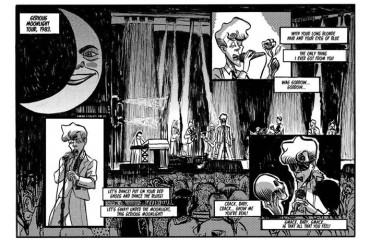
by Laura Fornasari
New York is noise and light. The uninterrupted traffic noise, and the far cry of sirens. Did you know that New Yorkers say it’s impossible to make a phone call without being interrupted by at least one siren? But New York designed by Giacomo Bevilacqua is made of colors and stains of shadows and lights drawing the profile of a skyscraper, branches of a tree in Central Park, white steps at the entrance of an apartment.
There are no sounds. We can only imagine them: we unconsciously do so when we dive into reading, to find out much later that the absence of noise has a definite and unexpected meaning.
At least apparently, the theme of this story is detachment. Samuel Page, journalist and photographer who decided to find inspiration with a challenge: to live for two months in New York without addressing to anyone. Days are marked by the rules of the game, the necessary contacts made of bookings, codes and badges. Everything seems to work … until a puddle of dust creeps into the gear. Sam realizes that in his photos taken around the city there is a girl, always the same. It cannot be a coincidence: not in the New York humanity cauldron. Precisely when the network of impossible rules seemed to work, there is a connection that goes beyond logic, ready to undermine Sam’s certainty, which in the game of total isolation believed he had found its balance.
It is difficult to explain what is Il suono del mondo a memoria (“The Sound of the World by Heart”). Sam accompanies us on a solitary journey, but not necessarily melancholy. There is New York to keep him company, the same city that suddenly decides to revolt against him.
Sam selects memories like his photographs. He chooses what to keep and what to throw. He chooses to isolate himself in the heart of a place that does everything to claim his attention. There is the fear of contact, the fear of the other, especially when the other is the only person of whom we cannot exclude the voice even by plugging our ears.
Il suono del mondo a memoria (“The sound of the world by heart”) is the first graphic novel by Giacomo Bevilacqua, known for his humorous cartoons A Panda Piace (“PandaLikes”). In contrast with the great silence of some of the boards, Sam’s narrative voice becomes ever-present, and makes us part of all his thoughts. So many and chaotic that end up clashing and bouncing everywhere, just like the marbles he mentioned in the box that should be New York.
The story is certainly a sweet dedication to the city by someone who loved it, although it remains the feeling that throughout the affair, the metropolis is a sort of backdrop rather than the protagonist. If history converges to a predictable total resolution, it is forgiven with the beauty of the boards and the colors, and with at least one surprise that will change the perspective with which we opened the volume for the first time.
Cover: The cover of Il suono del mondo a memoria, Bao Publishing, Milan 2016
 English
English  Italiano
Italiano 





